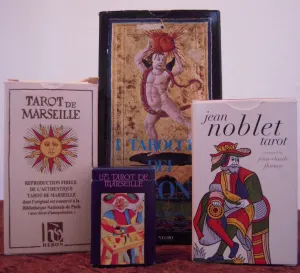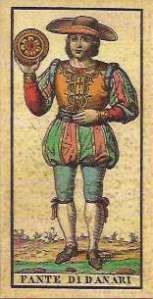Building a Collection of Historic Tarot Decks

What does it take to put together a tarot deck collection that covers every important era in Tarot’s 600-year history? After making a list and distilling it to the essentials, I found you could cover all the bases quite nicely with fourteen decks. If you stick to just the main highway of tarot evolution and avoid going down interesting by-ways, you can create a basic collection with just seven decks.
Here are my guidelines for a well-rounded collection comprised of decks that are affordable and readily available. The collection falls into five broad categories: Fifteenth century, Tarot de Marseilles, Occult, Rider-Waite-Smith, and contemporary decks. The basic collection has the oldest examples of each category. I’ve given suggestions for filling out the basic collection with additional essential decks; then I provide a shopping list at the end of the article.
The Visconti-Sforza is the only mainstream fifteenth-century deck that’s reasonably complete. Lo Scarabeo cleaned up the chipped paint and applied gold foil, restoring the deck to its original shimmering glory. Expand your collection with a photo-reproduction of this deck in its present condition (US Games and Dal Negro versions are the original size). Top off the 15th century with a one-of-a-kind deck like the Boiardo, Sola Busca or Estensi.
 Our collection jumps to the mid-eighteenth century with a photo-reproduction of the classic Tarot de Marseille printed by Nicolas Conver in 1760, or one of the museum facsimiles created by Yves Reynaud at Tarot-de-Marseille-Heritage. Your collection should also include Europe’s most popular deck, the Grimaud Tarot de Marseille, Paul Marteau’s version of the 1760 Conver deck.
Our collection jumps to the mid-eighteenth century with a photo-reproduction of the classic Tarot de Marseille printed by Nicolas Conver in 1760, or one of the museum facsimiles created by Yves Reynaud at Tarot-de-Marseille-Heritage. Your collection should also include Europe’s most popular deck, the Grimaud Tarot de Marseille, Paul Marteau’s version of the 1760 Conver deck.
Expand your TdM collection with a pre-Conver Tarot de Marseille like Jean-Claude Flornoy’s reproduction of the Dodal or Noblet Tarot; then add a TdM that doesn’t follow Conver exactly, such as decks by Giacomo Zoni or Claude Burdel. Consider adding a regional deck like the Soprafino or Bolognese, a deck that substitutes the Pope and Popesse, and a modern re-colored update.
Etteilla designed the first occult deck in the 1780s. The Falconnier-Wegener Egyptian design is historically important as the inspiration for many early twentieth century occult decks. Your basic collection should contain one of these. Expand the collection with your choice of another occult deck: Oswald Wirth, Aleister Crowley’s Thoth Tarot, or a Golden Dawn deck.
U.S. Games’ The Rider-Waite Tarot Deck in the yellow box isn’t the oldest version of the Waite Smith deck, but it has dominated the market since the mid twentieth century and should be part of the basic collection. The second half of the 20th century was defined by a thriving industry in re-coloring, re-drawing and re-visioning the RWS deck. Your basic collection should contain the oldest re-colored RWS, the Albano Waite Tarot, plus one of the early mass-market RWS spin-offs from the 1970s or 80s. Expand this part of your collection with a RWS deck that’s faithful to the earliest printings of 1909 and 1910.
A modern deck used for game playing and a Tarock deck would be nice additions to your collection.
Round off your basic collection with one or two contemporary decks. Pick a category and do research to find the first deck of its type. Some suggested categories:
Media – collage, photography, computer art, water color
Artistic Style – gothic, anime, cartoon, black and white, fantasy, round decks
Subject Matter – Arthurian, animals, gay, pagan, feminist, Norse, Native American
Go with what you love and create the nucleus of a focused collection.
Have I skipped any important categories, or given too much space to certain types? What does your deck collection look like? I’d love to hear from you.
Shopping List
Fifteenth Century
- Visconti Tarot Deck, Lo Scarabeo (the gold foil version)
- Visconti Sforza Tarocchi by U.S. Games, Inc., and I Tarocchi di Visconti by Dal Negro are photo-reproductions of the deck as it exists now in its original size. Il Meneghello’s I Tarocchi Visconti-Sforza is smaller.
Other 15th Century decks
- Matteo Maria Boiardo Tarocchi, Editore Tosi of Ferrara
- Ancient Enlightened Tarot (Sola Busca), Llewellyn
- Golden Tarot of the Renaissance (Estensi), Lo Scarabeo. (Several missing trumps are replaced by modern reproductions and the illustrated minor arcana are based on a 15th century fresco)
Tarot de Marseilles
- Tarot de Marseille, Heron (photo-reproduction of a deck in the Bibliotheque Nationale)
- Ancien Tarot de Marseille, Grimaud/France Cartes or Dusserre (Paul Marteau’s 20th century version)
- Facsimiles of decks that pre-date the classic 1760 Conver, created by Yves Reynaud at Tarot-de-Marseille-Heritage.
TdM I style
- The Jean Noblet Tarot by Jean-Claude Flornoy
- Jean Dodal Tarot, by Jean-Claude Flornoy
Non-Conver 18th and 19th Century TdMs close to the Conver pattern
- Tarots of Bologna, Lo Scarabeo
- Tarot de Marseille by Claude Burdel, Lo Scarabeo
- Classico Tarocco di Marsiglia, Il Meneghello
Regional TdM
- Bolognese: Tarocco Bolognese by Il Meneghello (Mitelli’s deck); Tarocchi di G. M. Mitelli, by Dal Negro
- Milanese: Tarocco Italiano Fabbrica Dotti 1845, Il Meneghello; Ancient Italian Tarot, Lo Scarabeo (a soprafino variant)
- Dellarocca’s Soprafino style: Classical Italian Tarot, Lo Scarabeo; Soprafino Tarot, Il Meneghello
- Flemish style: Tarot Jacques Vieville, Heron-Boechat (photo-reproduction from a deck in the Bibliotheque Nationale)
Papesse/Pope replaced
- 1JJ, AGMuller/U.S. Games
- Vandenborre Bacchus Tarot, U.S. Games/Carta Mundi
Modern TdM
- Le Tarot de Marseille, Fournier
- Universal Marseille Tarot, Lo Scarabeo (re-colored Burdel)
- Major Tom’s Tarot of Marseille
- Le Nouveau Tarot de Marseille by Colette Silvestre-Haeberle, FJP
Occult Decks
- Grand Etteilla, Grimaud/France Cartes (Many decks use the Etteilla name – this one is closest to his original designs.)
- Egyptian Tarot, U.S. Games, Inc. (Falconnier-Wegener’s design)
- Ibis Tarot, U.S. Games, Inc (a colored version of Falconnier-Wegener’s design)
- Oswald Wirth’s deck is very important, but all publications seem to be out-of-print except for Lo Scarabeo which is not faithful to the original.
- Aleister Crowley’s Thoth Tarot: Swiss Crowley Thoth Tarot Deck, or Crowley-Thoth Premier Edition, both by U.S. Games, Inc.
- Paul Foster Case’s B.O.T.A. (Builder’s of the Adytum) official deck
- C. Z. Zain’s Brotherhood of Light deck
- A choice of Golden Dawn decks: the Golden Dawn Magical Tarot by Sandra and Chic Cicero, Llewellyn; The Golden Dawn Tarot designed by Robert Wang and Israel Regardie; the Hermetic Tarot by Godfrey Dowson, U.S. Games, Inc.,
Rider-Waite-Smith
- Rider-Waite Tarot Deck, U.S. Games, Inc.
- Albano-Waite, U.S. Games, Inc. (the first re-colored RWS)
- Other re-colored RWS decks: Universal Waite, The Golden Rider, Radiant Rider-Waite Tarot, all by U.S. Games, Inc.
- Early RWS spin-offs: Aquarian Tarot by David Palladini, Morgan-Greer Tarot, Hanson-Roberts Tarot, all by U.S. Games, Inc.
- Facsimiles of early 20th century RWS decks by U.S. Games, Inc: The Pamela Colman Smith Commemorative Set and The Original Rider-Waite Tarot Set
Game Decks
- Tarocco Bolognese by Dal Negro or Modiano.
- Tarocchino Milanese by Masenghini
- Tarocchi Poliplastiche by Masenghini
- Tarocco Piemontese by Modiano
- Any Tarock deck
The Cartomancy Resources page has links for purchasing decks.


This is a fabulous article. May I share it via a link on my own website? I want my readers to see this. 😀
Of course you can share this! I’m so glad you like the post.